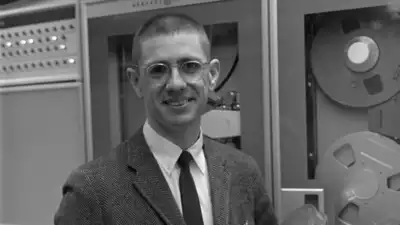
Thomas E Kurtz, a pioneering mathematician at Dartmouth College and an inventor of the simplified computer programming language known as BASIC, which allowed students to easily operate early computers and eventually propelled generations into the world of personal computing, died Tuesday in Lebanon, New Hampshire. He was 96.
The cause of his death, in a hospice, was multiple organ failure from sepsis, said Agnes Kurtz, his wife.
In the early 1960s, before the days of laptops and smartphones, a computer was the size of a small car and an institution like Dartmouth, where Kurtz taught, had just one. Programming one was the province of scientists and mathematicians and specialists. Kurtz and John G Kemeny, then the chair of Dartmouth’s maths department, believed that students would increasingly come to depend on computers and would benefit from understanding how to use them. “We had the crazy idea that our students, our undergraduate students who are not going to be technically employed later on, social sciences and humanities students, should learn how to use the computer,” Kurtz said in an interview in 2014. “Completely nutty idea.”
The two mathematicians created the Dartmouth Time-Sharing System, which allowed multiple users to share the processing power of a single computer simultaneously.
But the architecture of a system for sharing resources was not enough. Kurtz and Kemeny also wanted to give students an easier platform for understanding how the computers worked and functioned, and to allow them to code and run their own programs. “I think we could design a completely different way of using computers that would make it possible to give computer instruction to hundreds of students,” Kemeny recalled Kurtz saying.
Kemeny worked with Kurtz and undergraduate students to develop a novice-friendly and intuitive computer language called BASIC (the name was an acronym for Beginner’s All-Purpose Symbolic Instruction Code). It was a high-level programming language designed for ease of use, which could be used with the time-sharing system. The language was simple. Typing the command “RUN” would start a program. “PRINT” printed a word or string of letters. “STOP” told program to stop.
At 4am on May 1, 1964, in the basement of College Hall on the Dartmouth campus, the time-sharing system and BASIC were put to a test. A professor and a student programmer typed a simple command – “RUN” – into neighboring Teletype terminals and watched as both received the same answer simultaneously. It worked.
BASIC became the language of choice for students learning programming around the globe. The ability to access a computer and have it process data from multiple users at a single time was revolutionary. Allowing those same computer users to easily write their own programs was even bolder.
BASIC would provide the intellectual building blocks for later software and is still a fundamental tool in teaching computer programming. One student who later benefited from BASIC was Bill Gates, who used a variation of it as the foundation for the first Microsoft operating systems. Versions of BASIC still power computer operating systems today.








